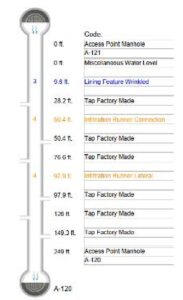HUMAN OR MACHINE, THE IMPORTANCE OF IMAGE CLARITY
By NASSCO member Tony Araujo, Vice President – Business Development, Paragon Systems Testing
In the United States alone there are nearly 800,000 miles of mainline sewers and 500,000 miles of lateral sewers. Over 90% of these mainline sewers are 6 to 15 inches in diameter. Now imagine that in each reach of sewer length, including adjacent manholes and connecting laterals, a human finds 100 condition-related observations to document. Under that scenario it is absolutely reasonable to end up with over two billion (with a B!) data entries to code and review using NASSCO Inc.’s Pipeline Assessment Certification Program (PACPTM), Lateral Assessment Certification Program (LACPTM), and Manhole Assessment Certification Program (MACPTM) coding standards, and then store for processing.
While PACP has proven to be remarkably successful at being a replicable language to accurately document pipe defects to establish overall condition, the human brain has long been limited to processing these images at a maximum of about 30 feet per minute to maintain that accuracy and replicability. If we keep doing the math, that is about 435 years of processing time for a first look at just wastewater pipes! Let alone, other horizontal assets like stormwater pipes and water mains.
One of the more remarkable technological advancements in image processing in the past two decades has been the use of machine learning (ML) and other rule-based techniques applied to all forms of image processing. However, just like the human brain the consistency of ML tools benefits a great deal from high clarity imagery. Unlike the human brain, the speed of processing is not limited to 30 feet per minute. In the field of medicine for example, there has been a radical improvement in the speed and accuracy of processing for image-based tools such as x-rays, MRIs and CAT scans, using what we generically reference as “artificial intelligence” (AI) techniques. To the authors of these tools, there is nothing artificial about it, but automated defect recognition (ADR) techniques present a new frontier in terms of greatly reducing processing time but in a manner that will increase quality and maintain image clarity, not compromise it. By definition, ADR is the software output, that uses machine learning (ML) techniques, to progressively identify defects “observed” within individual images of video.

These challenges facing medical practitioners are relatable to the challenges our underground infrastructure assessment industry is facing when it comes to incorporating new, shiny, faster, types of camera inspection equipment tools into our current processes.
An indisputable fact is that the quality and clarity of an image, whether being looked at by a human brain or an ADR technology, will ultimately determine the accuracy of what is observed. The difference between the two is one is limited by speed (the human brain) and the other is not (ADR). As noted above, one of unique aspects of ADR is that there is no 30 feet per minute restriction for accuracy.
So, how fast can ADR go while still making an accurate observation?

NASSCO and its ADR Workgroup, with the support of industry leaders and camera manufacturers, are working on just that, using sample data from 30-, 45-, and 60-feet per minute video data. For the time being, there may not be exact quantifications, but the use of ADR can help make observations and perform coding at much faster rates than the human brain can, while maintaining image clarity. This is wonderful news when we consider the amount of data out there still to be collected, first time or fifth time. Equally important is how we verify the output from advanced processing methods. Because without verification, the increased speed will be of very little value. Fortunately, in both the medical and infrastructure assessment industries, there are solid science-based approaches to solve this type of problem, including an ADR approach in CCTV inspections.
Continue to watch for written updates from NASSCO on this subject to inform the industry, our users, and our membership on the advancement of AI in the PACP-environment. With the release of Version 8.0 in January 2024, the manual and training already incorporate information to support a student’s understanding of the topic.
“AS A REMINDER, NASSCO REQUIRES LICENSE AGREEMENTS FOR ALL SOFTWARE PRODUCTS THAT UTILIZE NASSCO’S INTELLECTUAL PROPERTY RELATING TO PACP, LACP, AND MACP CODES, INCLUDING ADR AND IMPORT-EXPORT FUNCTIONS USING EXISTING PACP-INSPECTION DATABASES. INTERESTED VENDORS SHOULD CONTACT NASSCO FOR ASSISTANCE”
TECH TIPS IS A BI-MONTHLY ARTICLE ON TRENDS, BEST PRACTICES AND INDUSTRY ADVICE FROM NASSCO’S TRENCHLESS TECHNOLOGY MEMBERSHIP PROFESSIONALS
Follow us on social media or visit NASSCO.org